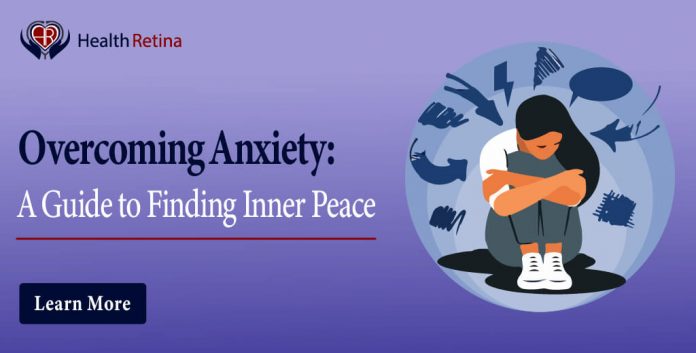Anxiety is a common and natural human emotion characterized by feelings of fear, worry, or discomfort. It is often accompanied by physical sensations such as increased heart rate, sweating, shaking, and irritability. While it’s normal to experience some level of anxiety in certain situations, such as before a big exam or an important presentation, it can become a problem when anxiety is persistent and excessive and interferes with a person’s daily life.
Anxiety disorders are a group of mental illnesses in which anxiety becomes chronic and overwhelming, affecting a person’s ability to function normally.
Generalized anxiety disorder:
Generalized anxiety disorder (GAD), panic disorder, social anxiety disorder, and specific phobias are the most prevalent anxiety disorders. These barriers can cause great stress and lead to avoidant behaviors to minimize or avoid anxiety-provoking situations.
The exact cause of anxiety disorders is not fully understood, but it is believed to be caused by a combination of genetic, environmental, and psychological factors. Traumatic events, chronic stress, certain medical conditions, and substance abuse can also contribute to the development of anxiety disorders.
Treatment for anxiety disorders may involve a combination of therapy, medication, and lifestyle changes. An approach that is frequently used to assist people in recognizing and altering unfavorable thought patterns and anxiety-related behaviors is cognitive-behavioral therapy (CBT). In some circumstances, doctors might recommend drugs like benzodiazepines or selective serotonin reuptake inhibitors (SSRIs). Anxiety can also be managed with the aid of self-care techniques like routine exercise, relaxation methods, stress management, and support from friends and family.
How to Recognize Anxiety Symptoms
The most typical anxiety warning signs and symptoms are as follows:
- Feeling nervous, restless, or nervous
- Feelings of imminent danger, panic, or doom
- Increased heart rate
- Shortness of breath (hyperventilation)
- Sweat
- Trembling
- Feeling weak or tired
- Inability to focus or think about anything besides current concerns
- I can’t sleep well
- Have gastrointestinal (GI) problems
- Difficulty controlling worry
- An urge to stay away from things that make you nervous
- There are different types of anxiety disorders.
How to survive anxiety?
Anxiety can be a challenging experience, but there are several strategies you can employ to help manage and reduce it. The following techniques could be helpful:
1. Practice deep breathing and relaxation techniques: Deep breathing exercises, such as diaphragmatic breathing, can help activate the body’s relaxation response and calm the mind. Progressive muscle relaxation and guided imagery are two additional relaxation methods that can be helpful.
2. Engage in regular physical exercise: Physical activity releases endorphins, which are natural mood enhancers and stress reducers. Regular exercise can help alleviate anxiety symptoms and promote a sense of well-being.
3. Maintain a balanced and healthy lifestyle: Ensure you are getting enough sleep, eating a nutritious diet, and avoiding excessive consumption of caffeine, alcohol, and other substances that can worsen anxiety symptoms. Maintaining a healthy lifestyle can support your overall well-being and mental health.
4. Practice Challenge negative thoughts: Anxiety often stems from negative thinking patterns and irrational beliefs. Learn to recognize and challenge these thoughts by asking yourself if there is evidence to support them. Substitute realistic and uplifting thoughts for negative ones.
5. mindfulness and meditation: Mindfulness involves paying attention to the present moment without judgment. Engaging in regular mindfulness meditation can help you develop a greater sense of calm and improve your ability to cope with anxiety.
6. Establish a support system: Share your feelings and concerns with trusted friends, family members, or a therapist. Having a support system in place can provide emotional support and practical advice when dealing with anxiety.
7. Set realistic goals and manage time effectively: Break down tasks into smaller, manageable steps to reduce feelings of overwhelm. Set aside time for self-care and relaxation, and prioritize your obligations.
8. Avoid excessive exposure to stressors: Identify the situations or triggers that tend to provoke your Anxiety, and try to minimize your exposure to them whenever possible. If certain situations are unavoidable, consider developing coping strategies to manage your anxiety in those contexts.
9. Consider professional help: If your anxiety becomes overwhelming or significantly interferes with your daily life, seeking support from a mental health professional, such as a therapist or counselor, can be beneficial. They can provide you with personalized strategies and techniques to manage anxiety effectively.
How do anxiety disorders affect children?
It’s normal for kids to experience some anxiety, worry, or fear occasionally. A child might be alarmed by a thunderstorm or a barking dog for instance.
These young people frequently get “stuck” on their issues. They struggle to carry out daily tasks like going to school, playing, and sleeping.
When considering how anxiety your child is, the idea of “getting stuck” is essential. It distinguishes between typical childhood worries and an anxiety disorder that requires medical attention. It might be time to get help if your child’s anxiety or worry is making it difficult for them to function.




